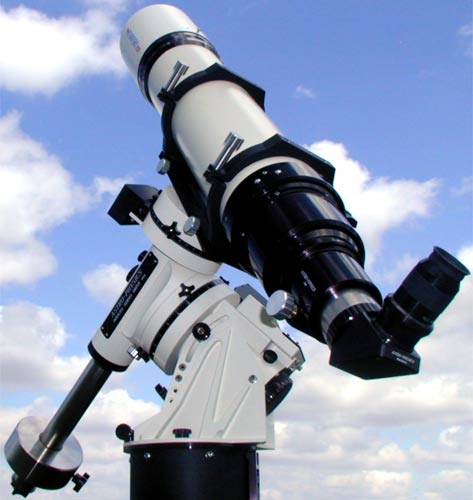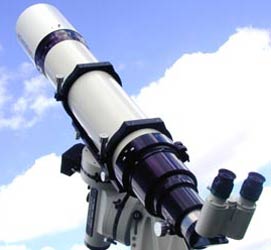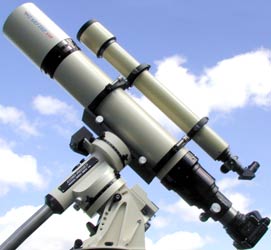


 |
  |
 More pictures of 155EDFS and other accessories
More pictures of 155EDFS and other accessories
Although we originally designed the 155mm f7 StarFire EDF (6.1" aperture) featuring our gigantic focuser and field flattener with the avid astrophotographer in mind, we have come to appreciate the versatility of this instrument. At the urging of our customers, we also offer the same excellent 155mm f7 lens in a lighter weight tube assembly with our 2.7" focuser.
We continue to be amazed at the compact size and weight of this instrument. At last, a 6.1" refractor with an overall length of 40" (with dewcap retracted) and weighing only 23 lbs! This is less than half the length of an f15 and approximately a foot shorter than an f9! In fact, it is about the same length as a 130mm f8, but with an inch more of aperture! You can transport it in a smaller car, store it in less space, invest in a smaller mount and shorter pier/tripod. This instrument is the fulfillment of the astronomer's dream for a truly portable 6.1" refractor.
The EDF is superb as a visual instrument. It is easily capable of high-power observations of the moon and planets. Secondary spectrum is nearly absent at any power which allows you to discriminate the subtle color variations on the surface of the planets. Deep-sky views are equally impressive due to the very high transmission of the three glass types. Performance will rival larger obstructed systems because the contrast is excellent. Individual stars of globular clusters are sharply etched against velvet black skies. A beautiful sight!
This refractor can, of course, be used photographically with a 35mm camera at prime focus with only a simple camera adapter or at a fast f5.2 with the optional flat-field telecompressor. A single element field flattener is available for the Pentax 6 x 7 medium-format camera, however the field is vignetted in the corners due to the restrictions of the 2.7" focuser (full coverage requires the 4" focuser/4" field flattener combination). The field flattener can be used with a 35mm camera or one of the newer CCD Cameras with the large chips by using the appropriate adapter. The 2.7" focuser is interchangeable with the 4" model should you choose at some time in the future to upgrade to the full EDF package.
Several mount choices are available for the 155 StarFire EDFS refractor. Many of our customers have chosen the 600EGTO mount (no longer produced, but available on the used market) and hardwood tripod combination (AWT000) for its light weight and easy portability. These astronomers are primarily interested in visual astronomy and occasional astrophotography. For more serious astrophotographers, the 900GTO or 1200GTO German Equatorials would provide a more solid base of support in conditions of light wind.
In the test report entitled "Astro-Physics Refractors Big & Small", in the September 1993 issue of Astronomy, Alan Dyer described the performance of the 155mm f7 EDF during his winter observing sessions. Please note that the article referred to this instrument as an EDT.
"Optical performance of the 155EDT was impressive. It produced nary a trace of false color even on Venus. Equally impressive, this scope provided superb images as soon as it was set outside. Even in sub-freezing temperatures, image quality, though not perfect at first, was surprisingly sharp from the start. In cold weather, after a modest settle-down time of 30 minutes, in-focus star images were textbook Airy disks with a well-defined first diffraction ring and a trace of a second outer ring. There was no sign of spherical aberration, lens figure changes, heat plumes, or distorted Airy disks due to tube turbulance."
We couldn't have said it better ourselves.
Specifications:|
Color correction |
Less than 0.01% focus variation from 405nm to 706nm (r to h wavelengths) Color correction curves. |
|
Clear aperture |
155mm (6.1") |
|
Focal length |
1085mm (43") |
|
Resolution |
0.74 arc seconds |
|
Coatings |
Multi-layer, overall transmission greater than 97% in peak visual wavelengths |
|
Magnification range |
20x to 600x |
|
Tube assembly |
White, 6.5" aluminum tube, baffled, flat black interior, push-pull lens cell, engraved retaining ring |
|
Focuser type |
2.7" I.D. Astro-Physics rack & pinion focuser, 4.15" travel; 2" and 1.25" adapters; 2.5" extension |
|
Telescope length |
1041mm (41") w/ dewcap fully retracted |
|
Weight with dewcap |
24 lbs. (10.9 kg) |
|
Carrying-case type |
Wood case with grey vinyl covering and foam-lined interior |
|
35mm Photographic field at prime-focus |
1.3 x 1.8 degrees @ f7 |
|
35mm Photographic field with telecompressor |
1.7 x 2.4 degrees @ f5.2 |
|
35mm Photographic field with 2x Barlow |
0.6 x 0.9 degrees @ f14 |
|
6x7cm Photographic field at prime focus |
3.2 x 3.7 degrees @ f7 (vignetted) |
Reviews and Related Articles
Author Unknown. "One Amateur's View of the Heavens", SkyWatch '99, pp. 110-112, featuring Carl Weber.
Dyer, Alan. "Astro-Physics Big & Small", Astronomy, September 1993, pp. 62-67.
Hallas, Tony and Mount, Daphne. "Fuji's Miraculous Super HG 400, Astronomy", September 1990, pp. 62-64.
Support
We have prepared some pertinent support documents relating to this scope and many of our other products on our Technical Support page. Please check there first to find the information that you need.
Upgrades and Spare Parts
Check out our Astro-Physics.com website to find accessories, replacement parts or learn about possible upgrades for your scope.
Copyright © 2004-2019 Astro-Physics Inc. All
rights reserved.
Last modified:
March 11, 2019
Astro-Physics, Inc.
11250 Forest Hills Road, Rockford, IL 61115, U.S.A.
Phone: 815-282-1513 Fax: 815-282-9847